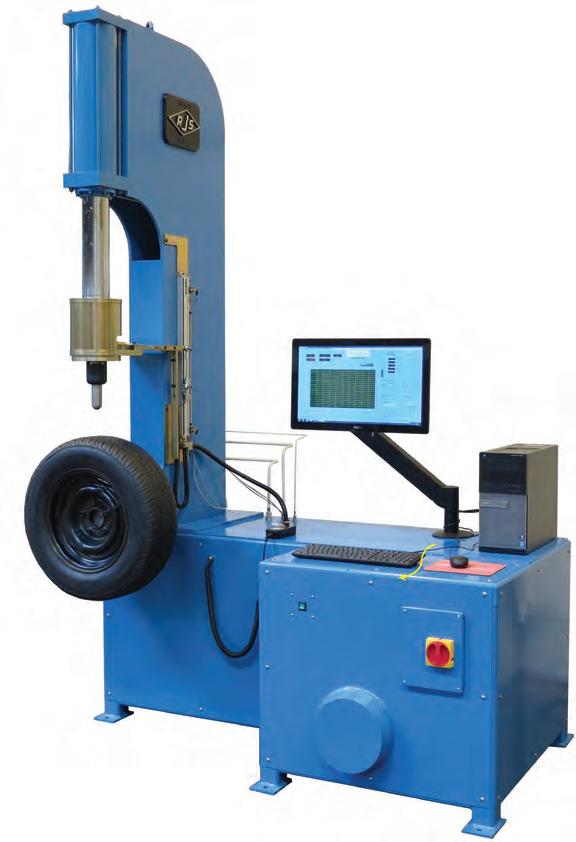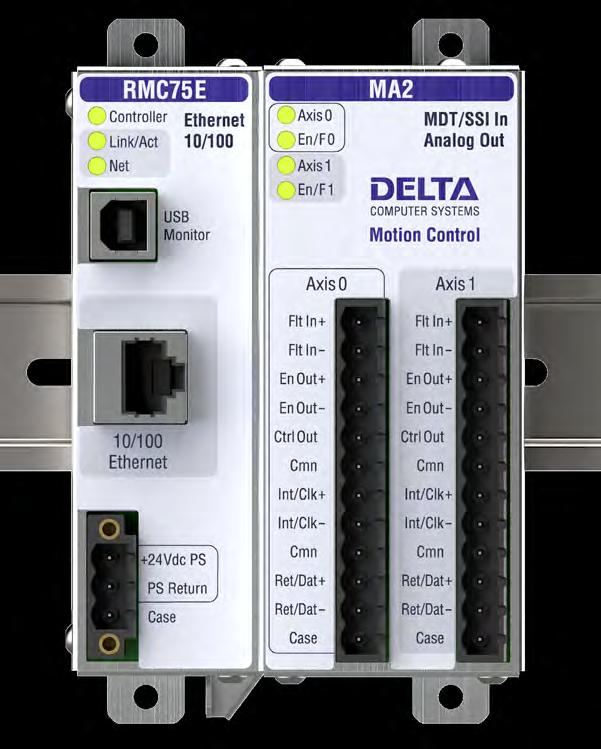
4 minute read
TESTER RETREAD
Digital hydraulic motion control overhauls legacy tire testing system.
BY DAVID MCNICHOL
Tires may be among the most ordinary of daily items, but their quality control remains paramount. Billions of people depend on tire integrity for their daily personal safety, and the tire market only reflects a growing need for product reliability. Testing and consultation firm, Smithers, pegged the global tire market at $261 billion in 2021, on track to exceed $325 billion by 2026. This is a huge industry, and it depends on reliable, accurate testing among manufacturers.
Much of this testing hinges on a few key devices, one of which is a tire plunger machine, such as the Model 70 from RJS Corp. With roots in the tire testing business dating back to the 1950s, RJS now has equipment placed in roughly 90% of tire factories worldwide.
Its Model 70 involves mounting a tire below a vertical plunger equipped with a probe. The machine conducts two tests: A bead unseating test, which presses on the tire sidewall to attempt unseating the bead from the rim, and a strength test, which presses into the tire tread to see if the tire will puncture under a given force. In both cases, the system measures force versus displacement. These tests are mandated by the United States Department of Transportation, within vehicle safety standards 109 and 119.
RJS was among the first to devise this sort of testing device. Early models from the 1960s and 1970s involved manual hydraulic controls, wherein users moved the cylinder with a lever and output could be read from a two-foot-wide analog dial.
Those analog systems remained the norm until roughly a decade ago, when RJS started on a path of digital modernization that would make testing systems easier to control, more accurate and better able to capture data. Much of the machine’s frame could remain the same, but the “guts” would incorporate new hydraulics and new electronics to replace old load cells, along with a motion control system to enable precision and automation.
Caught in the loop
Like many big innovations within product lines, the RJS’ move to modernized testing began as a pet project by one of the company managers. With a basic motion controller and a LabVIEW application, the RJS manager devised a working prototype…kind of.
According to RJS sales engineer Chad Zivich, the project was beset with “glitchy inconsistencies and unwanted oscillations.” For example, when users wanted the probe exactly three inches from the test start point, the probe tip might oscillate between 2.9 and 3.02 inches.
In RJS’s prototype design, software positioned the head of the hydraulic cylinder using a proportional-integral-differential (PID) loop control scheme. User input told the software the desired head position, and the cylinder used linear encoder feedback to report exact position.
Acceleration and adjustment on the path from present position to target were coordinated by scaling and tuning the three PID inputs. However, RJS found the tuning to involve an uncomfortable amount of “black magic.” An on-site technician from the controller manufacturer tried to remedy matters, but 90 minutes of work “devolved into just guessing.”
RJS Corp.’s Model 70 Mk IV Tire Plunger Machine, which widely performs tire safety tests, features digitally controlled hydraulics that increased performance precession and expanded reporting.
Despite that, the design revolved around trying to have precise positioning of only a single hydraulic cylinder, the task proved tougher than it appeared — at least with the controller being used. RJS ended up shelving the effort for a few years.
Then, in 2019, management decided that modernization needed to be a top priority. The company’s electrical lead had prior experience with Delta motion controllers and felt the application would be perfect for Delta’s strengths.
RJS procured a Delta RMC75E controller with expansion modules for analog and quadrature inputs as well as discrete I/O. Company technicians went through a brief product training and rewrote RJS’ existing software to work with the Delta RMC while still working with the same LabVIEW executable.The results were immediate.
“Right out of the box, it was working much smoother,” says Zivich. “I mean, even from when we first set it up, within five or 10 minutes, we were very satisfied with how it was running. The interface for making tuning adjustments was much smoother, and we really haven’t had to fuss with it.”
Better Support
Most notably, the oscillations that plagued RJS’s original design vanished upon changing to the Delta RMC. But this came on the heels of software configuration. Chad Zivich notes that Delta’s API was very user friendly and made relatively quick work of redeveloping RJS’ program logic. Essentially, Delta’s RMCTools environment asked for inputs, such as current and target positions, and ran with them.
RJS also found both the embedded help for RMCTools and factory live support helpful. This included sending an RJS electrical engineer to a one-week, on-site training seminar for Delta controls.

“The help and training made things really easy for us,” says Zivich. “The Delta support team was right there to help us get started as we were developing code on the front end of initial testing. And if we didn’t understand anything, they were extremely responsive in helping walk us through everything needed.”
New opportunities
The results of product quality and stellar support quickly paid off. Customer response has been entirely positive. A few customers had first-generation solutions with the original controller, and those that chose to upgrade to the new Delta-based control system noticed immediate performance improvements. The “glitches” that slowed down calibration work vanished.
Even more encouraging is that RJS sees this Delta RMC-based solution as opening up new business streams for the coming years. On one hand, the innovation has already led to a new product line evolution, the Model 70 Mk IV Tire Plunger.
Compared to legacy approaches with analog dials and handheld stopwatches, the Model 70 Mk IV offers a quantum leap in precision control and test result repeatability. The system easily adapts to deployment around the world, as users can instantly toggle between different units of measure, as regional norms dictate.
It also enables digital data output and extensive reporting that would have required countless hours of compiling and computation under manual systems. As Zivich notes, “Customers now get an accurate test the first time, every time.” RJS can already see the potential for a range of SKUs based around these new capabilities.
In addition, the original RJS concept from 2014 hints at another opportunity. A host of analog tire plunger solutions still sit in customer sites around the world. RJS proved that much of those designs (and costs) can be preserved while upgrading the innards to a Delta RMC and related digital components. Old testing investments can be given new life and greater productivity, potentially with new service contracts attached.
All in all, RJS sees the integration of Delta-based motion control as a pivotal development in its product line, a line separating the legacy analog past with a more productive, higher-value digital future. |DE www.rjscorp.com www.deltamotion.com










